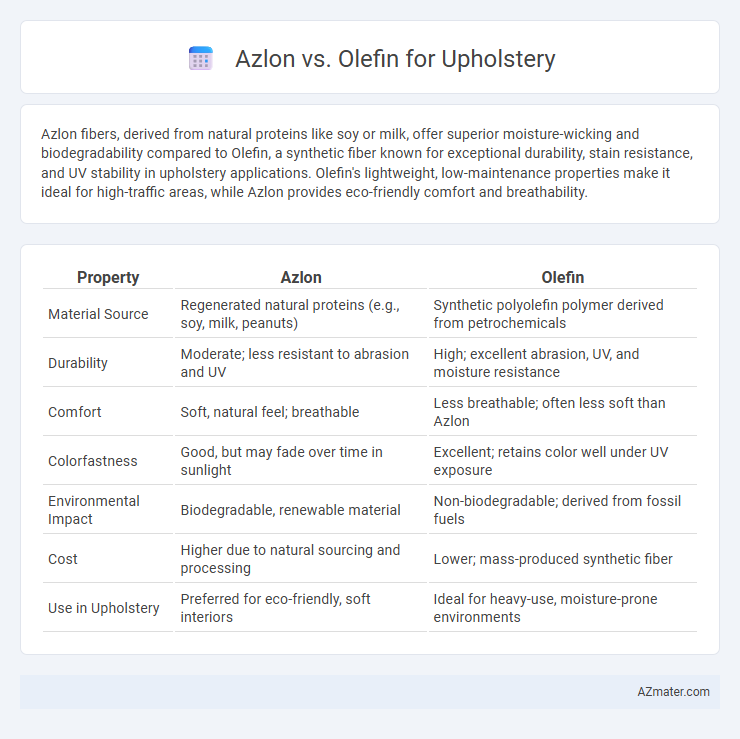Azlon fibers, derived from natural proteins like soy or milk, offer superior moisture-wicking and biodegradability compared to Olefin, a synthetic fiber known for exceptional durability, stain resistance, and UV stability in upholstery applications. Olefin's lightweight, low-maintenance properties make it ideal for high-traffic areas, while Azlon provides eco-friendly comfort and breathability.
Table of Comparison
| Property | Azlon | Olefin |
|---|---|---|
| Material Source | Regenerated natural proteins (e.g., soy, milk, peanuts) | Synthetic polyolefin polymer derived from petrochemicals |
| Durability | Moderate; less resistant to abrasion and UV | High; excellent abrasion, UV, and moisture resistance |
| Comfort | Soft, natural feel; breathable | Less breathable; often less soft than Azlon |
| Colorfastness | Good, but may fade over time in sunlight | Excellent; retains color well under UV exposure |
| Environmental Impact | Biodegradable, renewable material | Non-biodegradable; derived from fossil fuels |
| Cost | Higher due to natural sourcing and processing | Lower; mass-produced synthetic fiber |
| Use in Upholstery | Preferred for eco-friendly, soft interiors | Ideal for heavy-use, moisture-prone environments |
Introduction to Azlon and Olefin Fabrics
Azlon fabrics, derived from natural protein sources like corn or soy, offer exceptional biodegradability and softness, making them ideal for sustainable upholstery. Olefin, a synthetic fiber made from polypropylene, provides excellent durability, stain resistance, and colorfastness, suitable for high-traffic furniture applications. Both fabrics balance comfort and performance, but Azlon emphasizes eco-friendliness while Olefin prioritizes longevity and maintenance ease.
Key Characteristics of Azlon for Upholstery
Azlon fibers, derived from natural proteins such as soy, milk, or peanuts, offer excellent breathability and moisture-wicking properties, making them ideal for upholstery in climates requiring comfort and temperature regulation. Their biodegradability and eco-friendliness provide sustainable alternatives to synthetic Olefin fibers, which are known for high durability and stain resistance but lack natural biodegradability. Azlon's softness and ability to absorb dyes vividly enhance aesthetic appeal, whereas Olefin excels more in abrasion resistance and colorfastness.
Essential Properties of Olefin for Upholstery
Olefin, also known as polypropylene, is prized in upholstery for its excellent durability, stain resistance, and colorfastness, making it ideal for high-traffic areas. Its moisture-wicking and quick-drying properties prevent mold and mildew growth, enhancing longevity and hygiene. Olefin's resistance to abrasion and fading under sunlight ensures upholstery maintains its appearance and functionality over time, surpassing many alternatives like Azlon.
Durability Comparison: Azlon vs Olefin
Azlon fibers offer high durability with excellent resistance to abrasion, making them well-suited for heavy-use upholstery applications. Olefin fibers outperform in terms of moisture resistance and UV stability, providing long-lasting color retention and structural integrity in outdoor or high-humidity environments. Both materials deliver strong durability, but Azlon is preferred for indoor furniture subjected to frequent wear, while Olefin excels in outdoor or commercial settings demanding water and fade resistance.
Comfort and Texture: Which Feels Better?
Azlon fibers, derived from natural proteins like soy or corn, offer a soft, breathable texture that enhances comfort in upholstery applications. Olefin, a synthetic fiber made from polypropylene or polyethylene, provides a smooth, durable surface but lacks the warmth and natural feel of Azlon. For superior comfort and a plush touch, Azlon generally feels better than Olefin in upholstery.
Stain and Water Resistance: Azlon vs Olefin
Azlon fibers exhibit moderate stain resistance due to their natural protein structure, allowing some absorption of liquids but generally easy cleaning if treated properly. Olefin outperforms Azlon in water resistance, as its hydrophobic nature repels moisture and prevents staining, making it highly durable for upholstery exposed to spills. Comparing the two, Olefin offers superior stain and water resistance, providing longer-lasting performance in high-traffic, stain-prone environments.
Environmental Impact and Sustainability
Azlon fibers, derived from natural protein sources such as soy or milk, offer a biodegradable and renewable option for upholstery, significantly reducing environmental impact compared to synthetic fibers. Olefin, a synthetic fiber made from polypropylene or polyethylene, is highly durable and resistant to stains but is non-biodegradable and largely dependent on fossil fuels, contributing to long-term environmental waste. Sustainable upholstery choices favor Azlon due to its biodegradability and lower carbon footprint, while Olefin's production relies on non-renewable resources and creates challenges for end-of-life disposal.
Maintenance and Cleaning Requirements
Azlon upholstery fibers exhibit high durability and resistance to stains, requiring simple spot cleaning with mild detergent and water, making them low-maintenance options. Olefin fibers, known for their exceptional stain and moisture resistance, allow for easy cleaning with soap and water and are highly resistant to fading, offering excellent maintenance convenience. Both materials are suitable for heavy-use environments, but Olefin's superior resistance to wear and chemicals makes it especially favored for upholstery needing frequent cleaning and minimal upkeep.
Cost and Availability Analysis
Azlon upholstery fibers, made from regenerated protein sources, tend to be more expensive due to their eco-friendly production processes and limited manufacturing facilities. Olefin, a synthetic fiber derived from petrochemicals, offers a cost-effective alternative with widespread availability and a robust supply chain, making it popular for budget-conscious upholstery projects. The price difference between Azlon and Olefin can be significant, with Olefin generally favored for large-scale or commercial applications due to its consistent availability and lower material costs.
Which is Best for Your Upholstery Needs?
Azlon fibers offer natural moisture-wicking and breathability, making them ideal for upholstery in humid environments, while Olefin excels in durability, stain resistance, and colorfastness, perfect for high-traffic or outdoor furniture. Olefin's affordability and quick-drying properties suit families with pets and children, whereas Azlon's eco-friendly origin and comfort appeal to those prioritizing sustainability and softness. Your choice depends on balancing comfort, durability, and maintenance needs specific to your upholstery application.

Infographic: Azlon vs Olefin for Upholstery
 azmater.com
azmater.com